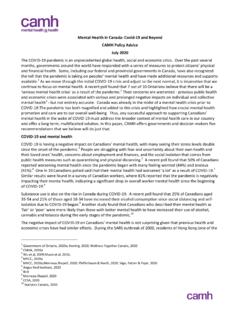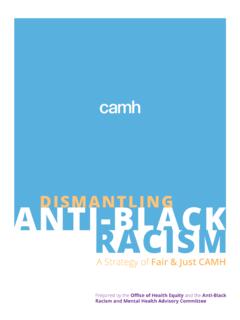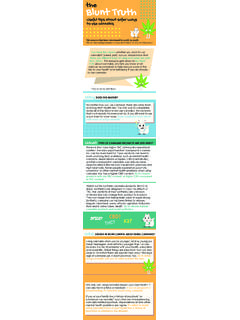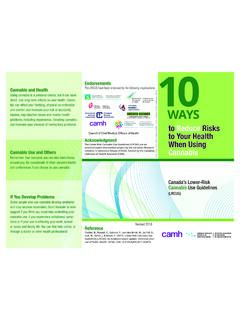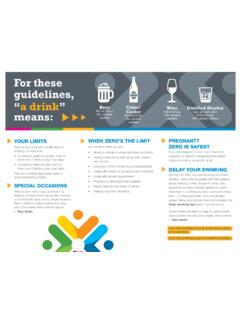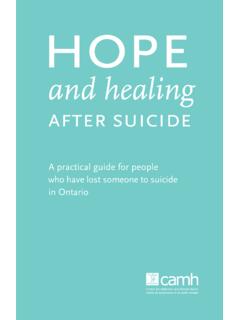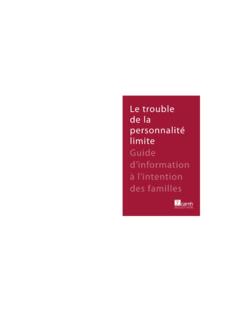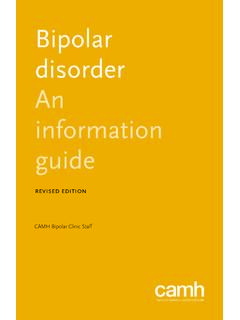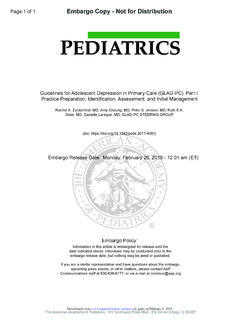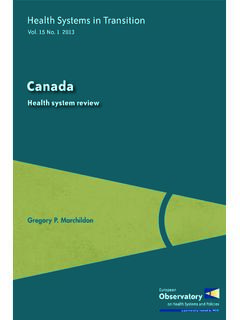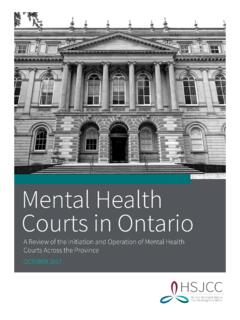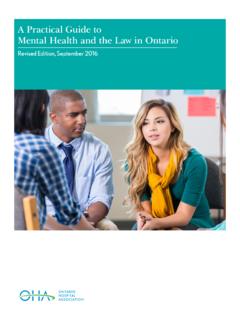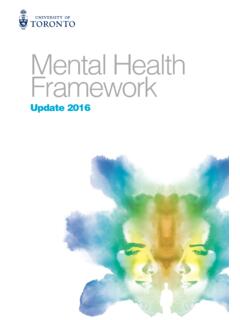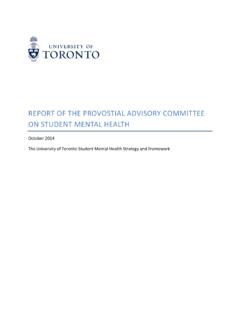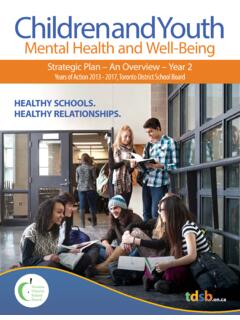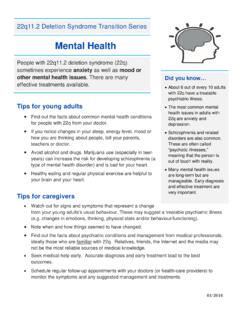Transcription of A guide for developing an awareness program for youth
1 TEACHER S RESOURCEA guide for developing an awareness program for youthiiTalking about mental Illness: A guide for developing an awareness program for youthTeacher s Resourceisbn 0-88868-401-0 Printed in Canada Copyright 2001 Centre for Addiction and mental HealthWith the exception of materials noted as handouts/overheads, which may be photocopied for use with students, and the evaluation forms, no part of this work may be reproduced ortransmitted in any form or by any means electronic or mechanical, including photocopying and recording, or by any information storage and retrieval system without written permissionfrom the publisher except for a brief quotation (not to exceed 200words) in a review or professional information on other Centre for Addiction and mental health resource materials or to place an order, please contact.
2 Marketing and Sales ServicesCentre for Addiction and mental Health33 Russell StreetToronto, onM5S 2S1 CanadaTel.: 1-800-661-1111 or 416-595-6059 in TorontoE-mail: site: illustration: Karine McDonaldiiiPREFACEThis guide contains all of the information, support and tools teachers will need to implement Talking about mental Illness in their classroom an awareness program that has been provento bring about positive change in students knowledge and attitudes about mental program supports teachers in four essential ways: 1) it outlines the links between the program and the new Ontario Secondary School Curriculum Guidelines; 2) it provides teacherswith practical, ready-to-use information on mental illness; 3) it offers teachers and students anopportunity to meet and interact with people who have experienced mental illness first-hand.
3 And 4) it provides links to community resources and support for further information and professional help. ivWHAT S INSIDE? The information contained in this guide includes: practical ideas and suggestions for secondary school teachers teaching about mental illness curriculum guidelines for a variety of courses showing how the program fits curriculumrequirements ready-to-use overheads and activities that address issues such as the impact of stigma on thelives of people with mental illness, and types, causes and treatments of mental illness evaluation tools to help teachers measure the program s impact on students knowledge andattitudes suggestions for resources and supports for The support, creative thinking and hard work of a number of people made thedevelopment of this guide possible. It was produced jointly by the following programpartners: the Centre for Addiction and mental health , the Canadian mental HealthAssociation, (Ontario Division), and the Mood Disorders Association of Ontario.
4 From the Centre for Addiction and mental HealthBarbara Steep, Project ManagerCatherine Willinsky Rozsa GuylayCindy SmytheRhonda MauricetteAndrea Stevens LavigneH l ne Philbin-WilkinsonJanice ColeTrevor WereleyNadia ZurbaLena Coppola Marty McLeodRena SchefferAcknowledgmentsviFrom the Canadian mental health Association, Ontario DivisionAllen FlamingFrom the Mood Disorders Association of OntarioEric JonassonJoan BassettA number of people gave generously of their time and expertise to review drafts of this document. We wish to acknowledge their contributions to the Teacher s Resource their comments and insights were invaluable. TeachersMary Lou Cortese, LondonHenry Winter, KitchenerKimberly Blacker, North BayDebra Walsh, KingstonMary Cunningham, TorontoCarole Whelan, TorontoCathy McConachie, TorontoScientific reviewersChristina Bartha, Administrative Director, Addictions, Child Psychiatry, Mood and Anxiety Programs, Centre for Addiction and mental HealthApril Collins, Manager, Schizophrenia and Continuing Care program , Centre for Addiction and mental HealthLauren Dixon, Therapist, Eating Disorders and Addictions Clinic, Centre for Addiction and mental HealthDr.
5 Paul Garfinkel, President and CEO, Centre for Addiction and mental HealthDr. David Goldbloom, Physician-in-Chief, Centre for Addiction and mental HealthDr. Marshall Korenblum, Psychiatrist-in-Chief, Hincks-Dellcrest Centre for ChildrenKaren Letofsky, Executive Director, Distress Centre 1 and Survivor Support ProgrammeDr. Ian Manion, Associate Director, Children s Hospital of Eastern Ontario Research InstituteDr. Gail McVey, Director, Ontario Community Outreach program for Eating DisordersCarolyn Michaud, Therapist, Intensive Therapy program , The Phoenix Centre for Children and FamiliesChristine Starr, Supervisor of Operations, Kid s Help PhoneMarion Wright, Executive Director, Canadian mental health Association, Halton and Grey Bruce BranchesviiCONTENTSP reface .. iiiWhat s inside? .. ivAcknowledgments .. vINTRODUCTIONBACKGROUND TO THE program .
6 1 OVERVIEW OF THE guide Who is this guide for? .. 2 What s in the guide ? .. 2 SECTION 1: INFORMATION ABOUT THE PROGRAMRATIONALE FOR THE PROGRAMWhat is stigma? .. 5 Why do we stigmatize mental illness? .. 6 How does stigma affect people s lives? .. 7 Why an awareness program ? .. 7 ContentsviiiHow does the program help to eliminate stigma? .. 8 What does this program offer young people? .. 9 OVERVIEW OF THE program .. 10 What is the purpose of the program ? .. 10 What are the goals and objectives of the program ? .. 10 Where does the program fit?: Links with the Ontario Ministry of Education and Training s curriculum guidelines .. 11 Looking at your school: School information survey .. 11 REFERENCES .. 12 FOR FURTHER READING .. 13 SECTION 2: CONTENT OF THE PROGRAMPROGRAM OUTLINE .. 15 program COMPONENTS.
7 16 Component 1 Stigma: What is it? How does it affect people s lives? .. 21 Educational activities: Descriptions, instructions and tools for Component 1 .. 22 Activity 1: Free association exercise .. 22 Activity 2: What is stigma? .. 23 Activity 3: Case studies .. 27 Activity 4: Art and literature .. 31 Activity 5: Famous people with mental illness .. 32 Component 2 What is mental illness? .. 39 Educational Activities: Descriptions, Instructions and Tools for Component 2 .. 40 Activity 1: Fact or fiction? .. 40 Activity 2: mental illness statistics for Ontario .. 44 Activity 3: Understanding mental illness: Definitions, possible causes and treatment46 Activity 4: Auditory hallucinations .. 57 Component 3 The presentation .. 61 Preparing for the presentation .. 61 Preparing your students .. 62 Preparation checklist for teachers.
8 63 Component 4 Follow-up activities and resources .. 65 Educational activities: Descriptions, instructions and tools for Component 4 .. 67 Talking about mental Illness: A guide for developing an awareness program for YouthixActivity 1: Analysis of media coverage .. 67 Activity 2: Dos and don ts brainstorm .. 67 Activity 3: Support strategies .. 69 Activity 4: Working and volunteering in mental health .. 71 Activity 5: Where to get help .. 71 Activity 6: awareness posters .. 71 Activity 7: Class newsletter or magazine .. 71 SECTION 3: EVALUATION OF THE PROGRAMWhy evaluate? .. 73 Past evaluations: Summary and results .. 73 How much evaluation should you undertake? .. 75 Making evaluation a success .. 75 Evaluation tools .. 76 Student evaluation Pre-test .. 77 Student evaluation Post-test .. 79 Teacher evaluation.
9 83 SECTION 4: APPENDICESA ppendix A: Ontario Ministry of Education and Training Curriculum Guidelines mental health .. 871) Healthy Active Living Education (Grade 11) .. 872) health for Life (Grade 11) .. 883) Introduction to Anthropology, Psychology and Sociology (Grade 11) .. 894) Media Studies (Grade 11) .. 915) Leadership and Peer Support (Grade 11) .. 926) Philosophy: The Big Questions (Grade 11) .. 947) Individuals and Families in a Diverse Society (Grade 12) .. 958) Healthy Active Living Education (Grade 12) .. 969) Challenge and Change in Society (Grade 12) .. 9610) Parenting and Human Development (Grade 12) .. 97 Appendix B: Useful mental health -related Web sites .. 99 mental health resources for educators .. 99 General mental health Web sites .. 99 Children and youth .. 100 Anxiety disorders .. 100 Eating disorders.
10 101 ContentsxMood disorders .. 101 Schizophrenia .. 101 mental illness and the arts .. 102 Appendix C: Resources for youth (alternative formats CD-ROMS, zines, on-line discussions) .. 103 Appendix D: Toll-free phone lines distress lines .. 107 Appendix E: Ontario mental health organizations .. 109 Appendix F: Suggested audiovisual resources .. 113 Documentaries .. 113 Feature films .. 115 Appendix G: Additional programs and resources .. 117 Substance use .. 117 Suicide prevention .. 118 Eating disorders .. 119 Appendix H: Overheads and handouts .. 1211 INTRODUCTIONBACKGROUND TO THE PROGRAMS tigma continues to be a huge problem for people living with mental illness. It undermines aperson s sense of self, relationships, well-being and prospects for recovery. Communities make adifference through education and awareness programs.


